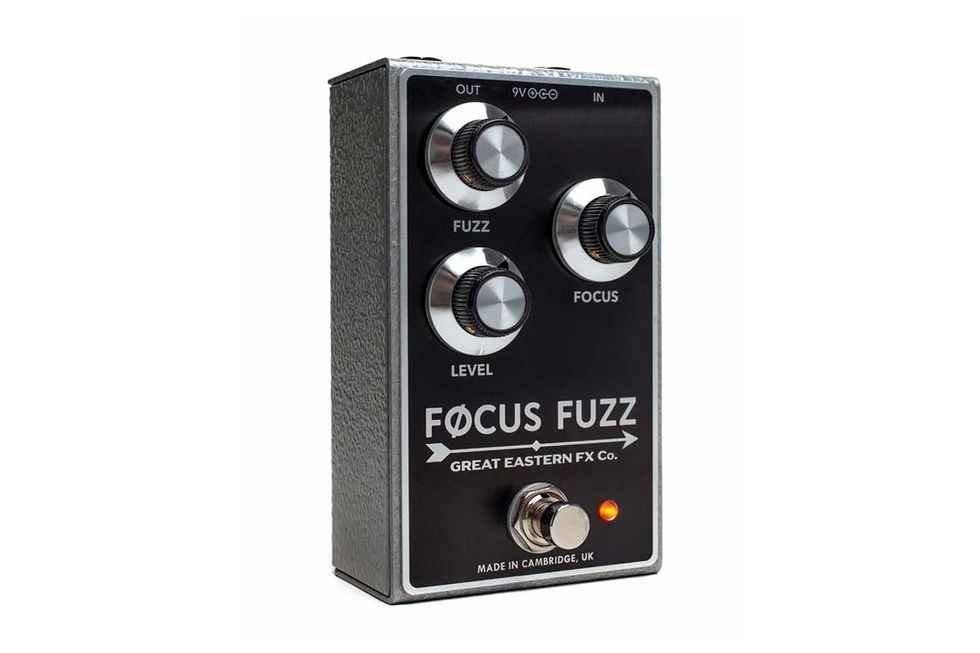Fuzz boxes don’t get much prettier than the Focus Fuzz from Great Eastern FX Co. And if you’re into mid-to-late-’60s fuzz, you may well find they don’t come much cooler sounding either. Great Eastern founder David Greeves describes the sound of the Focus Fuzz as something between a Tone Bender, a Fuzz Face, and a Dallas Rangemaster. Citing those touchstones is not unusual when reaching for a way to describe a new vintage-style fuzz. But in the case of the Focus Fuzz, Greeves isn’t making offhanded claims. The Focus Fuzz truly seems to thread a line between the open, bassier qualities of a germanium Fuzz Face and the fierce, metallic, buzzy compression of a Tone Bender. At lower gain settings, it approximates the performance of a Rangemaster in many respects. It’s responsive to playing guitar volume and tone dynamics. And it’s even tempered at both ends of the gain spectrum, too. Moderate gain settings dish bushels of killer overdrive sounds and jangly near-clean tones. If you can’t find a cool dirt sound here, you might consider frog farming instead.
Beautifully Constructed Deconstruction
Great Eastern hails from Cambridge, England—birthplace of the great Pink Floyd. And like the Floyd of old, Great Eastern has a clear affinity for provocative sounds. The company’s roster of effects is small but heavy on quality and substance and includes the much-too-modestly-named Small Speaker Overdrive and Design-A-Drive. The Focus Fuzz is built with the same sense of inventiveness and practicality that distinguishes those devices. Circuit construction is immaculately executed on through-hole board. And apart from a few hard-to-source parts, which we’ll get into later, the circuit looks easy to service if it fails. I suspect such incidents will be rare.
“The distortion is remarkable. It’s articulate and communicates individual string detail clearly, even at high-gain settings.”
The Focus Fuzz is more than well-built. It’s a clever effect that considers a lot of musical approaches and makes expression within different realms of gain and aggression easy. Apart from the cool fundamental fuzz voice—which so keenly splits the difference between Fuzz Face and Tone Bender—the real highlight of the Focus Fuzz circuit is the fuzz control, which also reduces bias voltage as gain is increased. The concurrent adjustment of the two tone ingredients is a huge part of what makes the Focus Fuzz sound so rich at lower fuzz volumes. And that’s a key difference between the Focus Fuzz and many classic circuits, which tend to get spitty and fractured at lower gain levels.
These boosted, overdriven, and sweetly distorted low- and mid-gain sounds are some of the Focus Fuzz’s finest voices. And within various, even slight adjustments of the gain and the focus control (which adds gain as you boost treble), you can find toothy Billy Gibbons tones, high octane jangle settings, punky grind, and many more shades of harmonically charged boost and drive. As for the Focus Fuzz in wide-open mode? Well, it’s a ripper. Lead tones are punky, focused, and white hot. Stooges riffs are explosive. And if you’re desperate to rage, the Focus Fuzz is beautiful therapy.
The Verdict
There’s only one bummer about the Focus Fuzz. It’s hard to find. Greeves initially limited production to 250 units—largely because the Russian invasion of Ukraine complicated sourcing the NOS transistors at the heart of the pedal. Greeves plans additional runs when he can obtain additional transistors. In the meantime, he's planning a silicon version that he can reliably keep in production.
However scarce the Focus Fuzz becomes, it’s worth seeking, buying, or borrowing. Because if you go into a session or a gig with unfamiliar backline or in new surroundings, the Focus Fuzz can be a source of much comfort and reassurance. If you’re patient enough to master the simple but complex relationships that can exist between the Focus Fuzz control array and the controls on your guitar, you can conjure scores of colorful treble-boosted, overdriven, distorted, and freak-fuzzed tones that can situate themselves boldly in a live or recorded setting. At around $285 at the time of this writing, the Focus Fuzz has a luxurious price tag, but its range and utility make the price seem relatively modest.




















